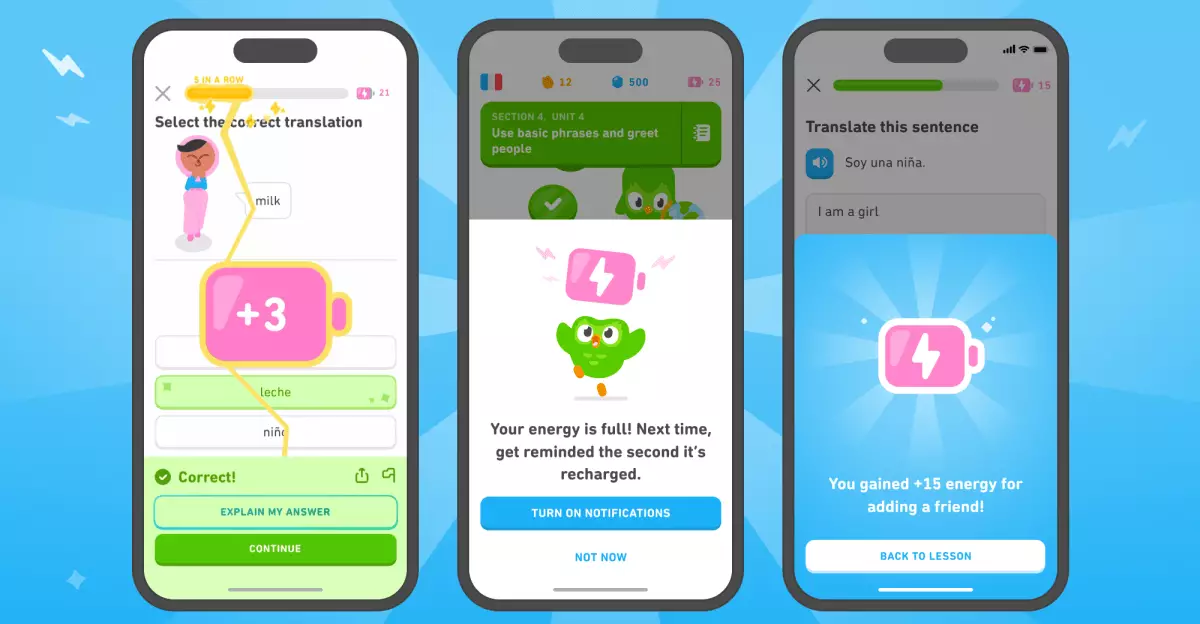Duolingo is embarking on a compelling transformation aimed at enhancing the language-learning experience. Traditionally, Duolingo employed a punitive system in which learners were penalized—losing “hearts”—for mistakes made during lessons. This structure created an environment where learners often felt disheartened, potentially discouraging them from continuing. However, the platform is moving towards a new paradigm: the introduction of an “energy” mechanic that focuses on encouragement over penalties. This fundamental shift promises to change not only how learners interact with the app, but how they perceive their journey of language acquisition.
The core tenet of the new energy system is to shift the focus from errors to accomplishments. Users will now expend energy to complete exercises, but rather than suffering penalties, they will be positively reinforced with extra energy for consistent correct answers. This gamification of learning is not just a gimmick; it’s a methodological approach rooted in psychological principles of motivation. By fostering an environment where achievements take precedence over mistakes, Duolingo is poised to cultivate a more engaged user base, and the early feedback indicates a successful reception of this new approach.
A Balanced System: Energy Regeneration and Accessibility
In its new framework, Duolingo has designed a more sustainable and user-friendly energy system. A learner starts with a full bar of 25 energy units, as opposed to the previous five hearts. This modular design allows for a greater number of lessons to be completed in one sitting. As a result, users can delve deeper into their studies without the looming fear of failing due to mistakes. Duolingo’s senior staff engineer, Moses Wayne, expresses the intention behind this design: “We wanted to find a way to gamify the experience a little more.”
The structured energy regeneration system mirrors the previous heart model, allowing users to regain energy over time or purchase additional energy with the in-app currency, Gems. However, there is also a liberating dimension for subscribers to Super Duolingo and Duolingo Max, who enjoy unlimited energy. This capitalizes on the growing trend of subscription services offering enhanced usability—a smart maneuver to attract and retain users in an increasingly competitive educational landscape.
Gamification at Its Best: Engaging Users through Fun Mechanics
At the heart of Duolingo’s newly revamped system lies the concept of gamification, an approach that has garnered significant attention in recent years for its ability to boost engagement. Wayne’s assertions that users can now “focus on things you’re getting right rather than penalizing for the things that you’re making mistakes on” encapsulate this philosophy perfectly. It is essential to transition away from the fear of failure that may accompany traditional learning methods.
The randomized rewards for completing multiple lessons correctly introduce an element of surprise and excitement into the learning process. When learners feel rewarded—not just for their persistence but for their successes—they are likely to invest more time and effort. This design aligns seamlessly with contemporary educational theories, which argue that motivation is an intrinsic and powerful driver of learning. In application, the implications are profound: increased lesson completion rates, enhanced user satisfaction, and a more profound engagement with language learning.
The Future of Language Learning: Embracing AI and Expanded Courses
Simultaneously, Duolingo’s recent announcement about becoming an “AI-first” company further underscores its commitment to modernizing educational technology. With the integration of artificial intelligence, the platform is not only doubling its language offerings but also enhancing the learning experience with personalized features tailored to individual user needs. As the landscape of technology and education continues to evolve, Duolingo is positioning itself to remain at the forefront of this transformation.
However, while the rollout of the energy system currently favors iOS users, the transition to a unified application experience across both iOS and Android remains a crucial next step. As the Android users will continue operating under the previous heart system, this disparity may lead to inconsistencies in user experience. Conscious efforts must be made to ensure that all users can equally benefit from the newly gamified approach to learning, paving the way for a more cohesive and rewarding education platform.
Duolingo’s strategic pivot towards an energy-based learning model signifies an optimistic future for language learners. The blend of motivation, accessibility, and a more uplifting approach reshapes language acquisition into a more engaging and fun activity. As these changes take root, the potential for fostering not just proficient speakers, but also enthusiastic learners, is both exciting and promising.

